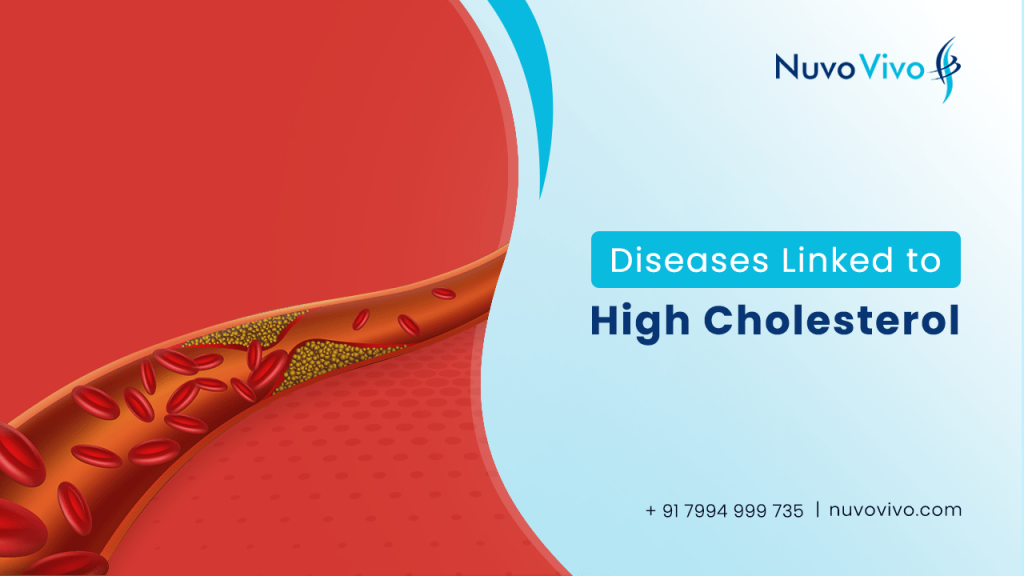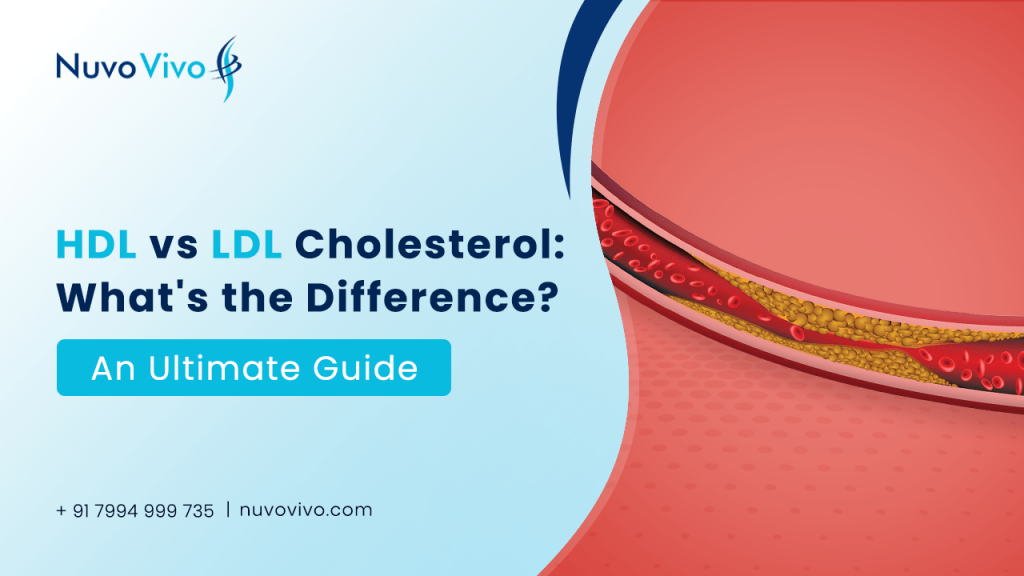Living a healthy life free of diseases and conditions is crucial. An individual should take extra care of their lifestyle with proper diet and regular exercise. Also, one should be aware of the various conditions that can affect the human body.
One of the most common health issues found in humans is high or low levels of cholesterol, which can lead to many deadly diseases and put one’s life in danger. Let us see more about LDL vs HDL cholesterol.
What is cholesterol?
Before going into the difference between HDL vs. LDL, let’s ponder over the definition of cholesterol. Cholesterol is a waxy, fat-like molecule found in the cells of the human body. Cholesterol is produced by your liver and may also be found in some meals, such as meat and dairy products. To function correctly, your body needs cholesterol. However, if your blood cholesterol level is too high, you’re more likely to get coronary artery disease.
Understanding HDL vs LDL cholesterol
Lipoproteins, which transport cholesterol to and from the heart, is made up of two types:
High-density Lipoprotein (LDL) is considered beneficial cholesterol because it recycles LDL cholesterol and transports it from the circulation to the liver. This safeguards us from heart attacks and strokes. High HDL levels protect us from heart disease, but they aren’t a panacea because HDL carries just one-fourth to one-third of the blood cholesterol.
Low-density Lipoprotein (LDL) is referred to as “bad cholesterol” because it leads to the formation of atherosclerotic fatty plaques in your arteries, increasing your risk of heart attacks and strokes. As the body produces more LDL cholesterol than it needs, excess levels are frequently obtained from food.
Even though LDL vs HDL is commonly known as cholesterol, triglycerides are also a major kind of fat present in your body and in the fat you eat. Triglycerides reveal what you’ve eaten recently, whereas cholesterol reveals what you’ve consumed over time.
When you consume a fatty meal, it is absorbed as triglycerides, so you will have elevated levels of triglycerides in your blood for the first few days thereafter. The liver converts part of the triglycerides into cholesterol and stores them as fat in your adipose tissue.
For a few days to weeks after consuming a fatty meal, this results in elevated cholesterol levels in the blood. Triglycerides, like cholesterol, are needed to keep the body healthy, but high amounts can cause health concerns.
Levels of HDL
- More than 60 mg/dL (optimal levels)
- a concentration of 40 to 60 mg/dL (good levels)
- a concentration of less than 40 mg/dL (low levels)
Levels of LDL
- a concentration of less than 100 mg/dL (optimal levels)
- a concentration of 100 to 129 mg/dL (borderline high levels)
- 159 mg/dL to 130 mg/dL (mildly high)
- 189 mg/dL to 160 mg/dL (high)
- 190 mg/dL and above (very high)
ALSO READ: Common Cholesterol Myths Debunked
What is the difference between HDL and LDL?
The two primary forms of cholesterol (blood fats, or lipids) that make up total cholesterol are LDL and HDL.
- HDL (high-density lipoproteins), sometimes known as “good” cholesterol, may protect the body against blood vessel constriction.
- LDL (low-density lipoproteins) cholesterol, sometimes known as “bad” cholesterol, may exacerbate arterial constriction.
Good cholesterol vs Bad cholesterol
High-density lipoprotein, or HDL, is commonly referred to as “good cholesterol.” It absorbs cholesterol and transports it to the liver for processing. It is then flushed from the body by the liver. High HDL cholesterol levels can reduce your risk of heart disease and stroke.
LDL or “bad cholesterol” transports cholesterol, which can clog arteries, aggregate in vessel linings to create plaque, and occasionally obstruct blood flow.
VLDL (very low-density lipoproteins) is the third form of cholesterol that is created in the liver and contains a large level of triglycerides.
Total cholesterol
Total blood cholesterol is made up of LDL cholesterol, HDL cholesterol, and other lipid components. When establishing your risk for heart disease and how to effectively treat it, your doctor will use your total cholesterol number.
- Age and sex are two factors outside of your control that might impact your cholesterol levels. Women’s and men’s cholesterol levels grow as they age. Women had lower total cholesterol levels than men of the same age before menopause. LDL (bad) cholesterol levels in women tend to rise after menopause.
- Heredity. Your genes have a role in the amount of cholesterol your body produces. High cholesterol levels in the blood can run in families.
ALSO READ: Can You Eat Honey If You Have Diabetes
Diseases linked to high cholesterol

Coronary heart disease and cholesterol
High cholesterol is the leading cause of coronary heart disease, which can result in death from a heart attack. Cholesterol can build up in the walls of your arteries if your cholesterol level is too high. Plaque builds up in the arteries over time, causing atherosclerosis (hardening of the arteries).
Arteries that provide blood to the heart might constrict in certain locations (focal narrowing) and cause blood flow to the heart muscle to slow. Alternatively, cholesterol plaques might break off and float into smaller blood vessels, causing partial or complete obstruction. Inflammatory cells may go to the location of the fractured plaque and produce a constriction there as well. Reduced blood flow can cause angina (chest discomfort) or a heart attack.
Stroke and cholesterol
Cholesterol plaques not only coat blood vessels in and around the heart but also constrict arteries leading to the brain. A stroke can occur when a blood artery transporting blood to the brain is entirely clogged.
Peripheral vascular disease and cholesterol
Cholesterol plaque can cause symptoms in your legs and other locations outside of your heart and brain, in addition to your heart and brain (peripheral vascular disease). The most prevalent parts are the legs and feet. When you walk, you may get cramps in your calves that improve with rest. This is similar to Angina Pectoris.
Diabetes and cholesterol levels
The ratio of HDL (good) cholesterol to LDL (bad) cholesterol can affect diabetes. LDL particles attach to arteries and damage blood vessel walls more easily in people with diabetes. Lipoproteins are attached to glucose (a form of sugar) and form a cholesterol-protein package that enables cholesterol to travel through the blood.
Sugar-coated LDL lingers in the circulation longer, perhaps aiding plaque formation. Low HDL and high triglyceride (another form of blood fat) levels are common in people with diabetes, particularly type 2 diabetes. Both of these factors increase the likelihood of heart and arterial disease.
High blood pressure and cholesterol
Although high blood pressure (also known as hypertension) appears to be connected to cholesterol levels, doctors are still researching the specific mechanism. High cholesterol appears to cause inflammation and the production of hormones that tighten or “constrict” blood vessels, raising blood pressure. When blood vessels act in this way, doctors refer to it as “endothelial dysfunction.”
Measures for a healthy life
When it comes to cholesterol management, there are modifiable and nonmodifiable risk factors. The following are some healthy lifestyle strategies to be aware of if you want to reduce your risk of cardiovascular disease:
- Keeping track of normal blood pressure levels.
- Keeping blood sugar levels within normal limits is an important part of a healthy lifestyle and reduces the risk of high or low levels of HDL or LDL.
- Exercising. The Centers for Disease Control and Prevention (CDC) and the United States Preventive Services Task Force (USPSTF) both suggest 150 minutes of moderate-intensity exercise every week. LDL levels have been proven to be reduced by maintaining a healthy weight, while HDL levels are increased by increasing physical activity.
- Eating a diet that is good for your heart. This includes soluble fiber in the range of 10 to 20 grams, low-sodium meals, and a diet rich in fruits and vegetables. Non-HDL levels have been proven to be reduced by increasing fish oil, niacin, and fiber in your diet.
- Consumption of red meat should be limited. Many people embrace plant-based and whole-food diets like the DASH and Mediterranean diets since red meat consumption has been linked to increased LDL levels. The DASH diet is a nutritious eating plan that can help you manage or avoid high blood pressure (hypertension). Foods high in potassium, calcium, and magnesium are included in the DASH diet. These nutrients aid with blood pressure management. The diet restricts sodium-rich, saturated-fat-rich, and sugar-rich foods.
- Quitting Smoking. Smoking has been demonstrated to increase LDL levels while decreasing HDL levels. Quitting smoking is one of the most efficient and effective strategies to improve your cholesterol profile.
Foods to increase HDL
There are a lot of food items that can increase the LDL levels in your total cholesterol, including fried items, cheese, ice cream, fatty food items, etc. Therefore, it is important to have a healthy diet to keep your LDL levels normal and have a better HDL level. The foods that raise HDL levels include:
- Olive oil
- Whole grains
- Beans and legumes
- High fiber fruits and vegetables
- Omega-3 rich fatty fish
- Flax seeds
- Nuts
- Chia Seeds
- Soy
- Avocados, and many more.
How often should I have my cholesterol levels checked?
Your age, risk factors, and family history all influence when and how often you should obtain a cholesterol test. The following are some broad suggestions:
For those under the age of 19 years old:
- The first test should be done when the child is between the ages of 9 and 11.
- Every 5 years, children should be tested again.
- If there is a family history of high blood cholesterol, heart attack, or stroke, some children may get this test starting at the age of two.
People over the age of 20 should:
- The exam should be repeated every 5 years for younger adults.
- It should be done every 1 to 2 years for men 45 to 65 and women 55 to 65.
ALSO READ: Gluten: Health Benefits, Risks, and Gluten-free Diet
What should you ask your doctor?
If your cholesterol levels are high, you should ask your doctor these questions at your next appointment.
- Can I take medication for an extended period of time? What are the negative consequences? Is it dangerous to use for a long time?
- How might exercise aid in the reduction of my cholesterol?
- What are the risks associated with having high cholesterol? Are there any additional issues that might arise?
- What may be the source of my elevated cholesterol? Is it a hereditary condition?
- Is there any way I can lower my cholesterol at home or in my daily life?
- Is it required to take medicine? Are there any other options for treatment?
- If medication is required, how does it work?
- Where can I find out more about managing high cholesterol?
A word of advice
Now that you are aware of the difference between HDL vs LDL and have got the answers to the questions: Is HDL good or bad? or “Why is HDL good and LDL bad?”, consider having a proper health checkup and finding out if you’re healthy or not.
High cholesterol is a cause for worry but can be controlled with regular exercise and a proper diet, including foods to raise HDL. But, in most circumstances, it’s a red flag. Although having high cholesterol does not guarantee that you will develop heart disease or have a stroke, it should be addressed carefully. Your risk of heart disease and stroke will almost certainly drop if you have high cholesterol and take steps to lower it. Cholesterol-lowering lifestyle changes also benefit your general health.


This Post Has One Comment
very well explained the major differences between HDL and LDL